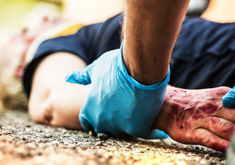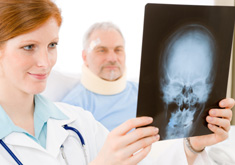Lesiones abdominales en el “encontrado caído”

1. L.Z. Kornblith, M.E. Kutcher, A.E. Evans, et al. The “found down” patient: A diagnostic dilemma. J Trauma Acute Care Surg, 74 (2013), pp. 1548–1552
2. W.A. Buylaert. Coma induced by intoxication. Acta Neurol Belg, 100 (2000), pp. 221–224
3. F.M. Hustey, S.W. Meldon, M.D. Smith, C.K. Lex. The effect of mental status screening on the care of elderly emergency department patients. Ann Emerg Med, 41 (2003), pp. 678–684
4. W. Kanich, W.J. Brady, J.S. Huff, et al. Altered mental status: evaluation and etiology in the ED. Am J Emerg Med, 20 (2002), pp. 613–617
5. J.J. Johnston, S.J. McGovern. Alcohol related falls: an interesting pattern of injuries. Emerg Med J, 21 (2004), pp. 185–188
6. J.L. O’Loughlin, Y. Robitaille, J.F. Boivin, S. Suissa Incidence of and risk factors for falls and injurious falls among the community-dwelling elderly. Am J Epidemiol, 137 (1993), pp. 342–354
7. J.T. Owings, D.H. Wisner, F.D. Battistella, et al. Isolated transient loss of consciousness is an indicator of significant injury. Arch Surg, 133 (1998), pp. 941–946
8. J.A. Morris Jr., E.J. MacKenzie, A.M. Damiano, S.M. Bass. Mortality in trauma patients: the interaction between host factors and severity. J Trauma, 30 (1990), pp. 1476–1482
9. G. Barmparas, D.Z. Liou, A.W. Lamb, et al. Prehospital hypertension is predictive of traumatic brain injury and is associated with higher mortality. J Trauma Acute Care Surg, 77 (2014), pp. 592–598
10. M.A. Purtill, K. Benedict, T. Hernandez-Boussard, et al. Validation of a prehospital trauma triage tool: a 10-year perspective. J Trauma, 65 (2008), pp. 1253–1257
11. M.O. Aaland, K. Smith. Delayed diagnosis in a rural trauma center. Surgery, 120 (1996), pp. 774–779
12. T.A. Mitchell, T. Hutchison, T.E. Becker, et al. Nontherapeutic laparotomy in American combat casualties: A 10-year review. J Trauma Acute Care Surg, 77 (2014), pp. S171–S175
13. A. Kimura, N. Tanaka. Whole-body computed tomography is associated with decreased mortality in blunt trauma patients with moderate-to-severe consciousness disturbance: a multicenter, retrospective study. J Trauma Acute Care Surg, 75 (2013), pp. 202–206
14. D.O. Verbeek, I.A. Zijlstra, C. van der Leij, et al. Predicting the need for abdominal hemorrhage control in major pelvic fracture patients: the importance of quantifying the amount of free fluid. J Trauma Acute Care Surg, 76 (2014), pp. 1259–1263
15. A. Surendran, A. Mori, D.K. Varma, R.L. Gruen. Systematic review of the benefits and harms of whole-body computed tomography in the early management of multitrauma patients: are we getting the whole picture? J Trauma Acute Care Surg, 76 (2014), pp. 1122–1130
16. M.J. Sise, J.E. Kahl, R.Y. Calvo, et al. Back to the future: reducing reliance on torso computed tomography in the initial evaluation of blunt trauma. J Trauma Acute Care Surg, 74 (2013), pp. 92–99
17. P.J. Bode, M.J. Edwards, M.C. Kruit, A.B. van Vugt. Sonography in a clinical algorithm for early evaluation of 1671 patients with blunt abdominal trauma. Am J Roentgenol, 172 (1999), pp. 905–911
18. J.D. Pal, G.P. Victorino. Defining the role of computed tomography in blunt abdominal trauma: use in the hemodynamically stable patient with a depressed level of consciousness. Arch Surg, 137 (2002), pp. 1029–1033
19. G.C. Velmahos, K.G. Toutouzas, R. Radin, et al. Nonoperative treatment of blunt injury to solid abdominal organs: a prospective study. Arch Surg, 138 (2003), pp. 844–851
20. A. Salim, B. Sangthong, M. Martin, et al. Whole body imaging in blunt multisystem trauma patients without obvious signs of injury: results of a prospective study. Arch Surg, 141 (2006), pp. 468–473 discussion 473–475
21. M.G. McKenney, L. Martin, K. Lentz, et al. 1,000 consecutive ultrasounds for blunt abdominal trauma. J Trauma, 40 (1996), pp. 607–610 discussion 611–612
22. D. Stengel, K. Bauwens, J. Sehouli, et al. Emergency ultrasound-based algorithms for diagnosing blunt abdominal trauma. Cochrane Database Syst Rev, 18 (2) (2005), p. CD004446
23. N.Y. Patel, J.M. Riherd. Focused assessment with sonography for trauma: methods, accuracy, and indications. Surg Clin North Am, 91 (2011), pp. 195–207
24. T.M. Scalea, A. Rodriguez, W.C. Chiu, et al. Focused Assessment with Sonography for Trauma (FAST): results from an international consensus conference. J Trauma, 46 (1999), pp. 466–472
25. J. Menaker, S. Blumberg, D.H. Wisner, et al. Use of the focused assessment with sonography for trauma (FAST) examination and its impact on abdominal computed tomography use in hemodynamically stable children with blunt torso trauma. J Trauma Acute Care Surg, 77 (2014), pp. 427–432
26. A.Y. Sheng, P. Dalziel, A.S. Liteplo, et al. Focused Assessment with Sonography in Trauma and abdominal computed tomography utilization in adult trauma patients: trends over the last decade. Emerg Med Int, 2013 (2013), p. 678380
27. D.K. Nishijima, D.L. Simel, D.H. Wisner, J.F. Holmes. Does this adult patient have a blunt intra-abdominal injury? JAMA, 307 (2012), pp. 1517–1527
28. J.F. Holmes, D.H. Wisner, J.P. McGahan, et al. Clinical prediction rules for identifying adults at very low risk for intra-abdominal injuries after blunt trauma. Ann Emerg Med, 54 (2009), pp. 575–584
29. B.R. Boulanger, B.A. McLellan, F.D. Brenneman, et al. Emergent abdominal sonography as a screening test in a new diagnostic algorithm for blunt trauma. J Trauma, 40 (1996), pp. 867–874
30. M.T. Miller, M.D. Pasquale, W.J. Bromberg, et al. Not So FAST. J Trauma, 54 (2003), pp. 52–60
31. P.A. Poletti, S.E. Mirvis, K. Shanmuganathan, et al. Blunt abdominal trauma patients: can organ injury be excluded without performing computed tomography? J Trauma, 57 (2004), pp. 1072–1081
32. S. Huber-Wagner, R. Lefering, L.M. Qvick, et al. Effect of whole-body CT during trauma resuscitation on survival: a retrospective, multicentre study. Lancet, 373 (2009), pp. 1455–1461
33. E.L. Jones, R.T. Stovall, T.S. Jones, et al. Intra-abdominal injury following blunt trauma becomes clinically apparent within 9 hours. J Trauma Acute Care Surg, 76 (2014), pp. 1020–1023
34. L.N. Gonser-Hafertepen, J.W. Davis, J.F. Bilello, et al. Isolated free fluid on abdominal computed tomography in blunt trauma: watch and wait or operate? J Am Coll Surg, 219 (2014), pp. 599–605
35. W.S. Hoff, M. Holevar, K.K. Nagy, et al. Practice management guidelines for the evaluation of blunt abdominal trauma: the East practice management guidelines work group. J Trauma, 53 (2002), pp. 602–615
36. G.C. Velmahos, A. Jindal, L.S. Chan, et al. “Insignificant” mechanism of injury: not to be taken lightly. J Am Coll Surg, 192 (2001), pp. 147–152
37. J.L. Sperry, L.M. Gentilello, J.P. Minei, et al. Waiting for the patient to sober up: effect of alcohol intoxication on glasgow coma scale score of brain injured patients. J Trauma, 61 (2006), pp. 1305–1311
Comentarios
Para ver los comentarios de sus colegas o para expresar su opinión debe ingresar con su cuenta de IntraMed.













